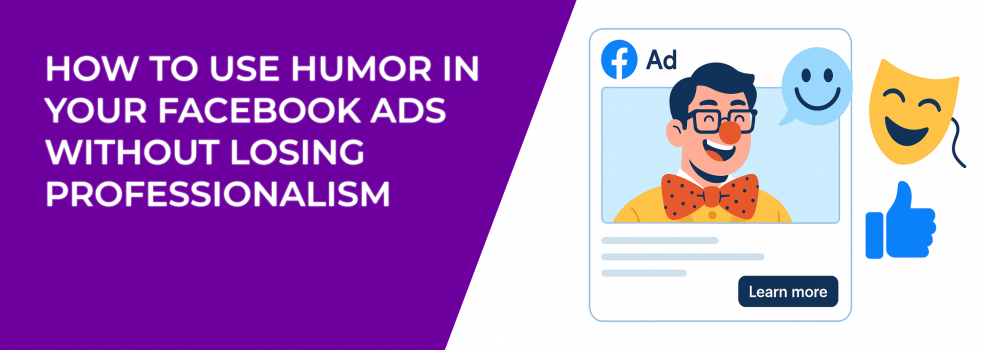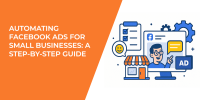Humor can make your Facebook ads stand out in a crowded feed. It grabs attention, gets people to stop scrolling, and helps your brand feel more relatable. But humor can backfire if it feels forced, off-brand, or unprofessional.
So how do you strike the right balance — entertaining your audience without losing trust?
Let’s walk through how to use humor in a smart, intentional way that supports your business goals.
Start with your brand voice
Before you try to be funny, take a good look at how your brand already communicates. Humor works best when it feels like a natural extension of your voice — not a complete personality shift.
Ask yourself:
-
Do we usually sound casual or formal?
-
Are we informative, friendly, bold, or understated?
-
What kind of language and tone do our customers respond to?
If your brand is usually serious, start with light touches of humor — a clever line, a playful image, or a subtle joke. If your tone is already relaxed, you might have more room to experiment with bold or silly content.
Stay consistent. Don’t suddenly switch styles just for one ad. People notice when something feels off, and inconsistency can confuse or even turn off your audience.
If you're not sure who your humor should speak to in the first place, start by understanding how to segment your audience effectively — here's a helpful breakdown in our Facebook Ad Targeting 101 guide.
Use humor to highlight real pain points
The best humor often comes from shared experiences. Your ads don’t need to be full of jokes — just relatable.
Think about what your audience struggles with. Then, use humor to show them you get it.
For example:
-
If you sell a fitness app, poke fun at people using wine bottles as dumbbells.
-
If you run a scheduling tool, show a chaotic calendar that’s completely out of control.
-
If you offer meal kits, show someone “cooking” cereal or instant noodles for dinner.
But be careful not to make fun of your customers. The joke should be about the problem — not the person. You want them to laugh and nod along, not feel embarrassed or judged.
Focus on empathy first, then humor.
Let visuals do the heavy lifting
Words aren’t always enough. In fact, on Facebook and Instagram, visuals are often the part that makes or breaks an ad — especially when it comes to humor.
A quick video of someone trying (and failing) to cook dinner with a hammer instead of a spatula can land harder than a punchline. A messy desk overflowing with sticky notes can make people laugh and think about how much they need better task management. These moments don’t need much explanation. They speak for themselves.
Just make sure your creative still looks professional. Humor should never come at the expense of quality. Blurry visuals or bad editing make your brand look sloppy, not funny. Use clean, sharp images or videos and tie everything back to your message.
People might laugh at the visual, but they should remember what you’re offering too.
Test different styles and see what works
Humor is tricky. What’s funny to one group may fall flat with another.
That’s why testing is so important.
Run a few different versions of your ad:
-
One with humor, one without.
-
Two different tones of humor (light vs. bold).
-
Different headlines, visuals, or captions.
Watch the results. Are people clicking? Commenting? Converting? You might find that funny ads get more attention, but fewer conversions — or vice versa. That’s valuable insight.
Also, pay attention to the comments and reactions. If people seem confused or turned off, the humor might be missing the mark.
Let the data guide your next move.
Make sure your message is still clear
Humor should support your goal, not distract from it.
Every ad needs a clear takeaway. Whether you want people to sign up, buy, or click through, your call to action should be obvious — even in a funny ad.
Let’s say you run a project management app. Your ad might show someone drowning in sticky notes. That’s great for a laugh — but don’t forget to follow it with a message like, “Stay on top of tasks. Try [Your App] for free”.
Some quick tips here:
-
Keep the copy focused and don’t overcomplicate the joke.
-
Avoid inside jokes or niche references unless your audience knows them.
-
Make sure the CTA is easy to spot and makes sense with the humor.
You’re still running an ad — not writing a skit.
Want help striking that balance between personality and persuasion? Here’s a full walkthrough on writing ad copy that converts without losing your tone.
Humor builds connection when done right
Humor helps people see the human side of your business. It can make your brand feel more approachable, more confident, and more in tune with your audience.
But if it’s done poorly (if it feels off, inconsistent, or unprofessional), it can hurt more than help.
So before you publish a funny ad, ask yourself:
-
Does this feel true to our brand?
-
Are we making fun of the problem, not the customer?
-
Is the CTA clear and easy to follow?
-
Will our audience get the joke?
Humor works because it taps into emotion, and when you understand the psychology behind what makes people pay attention, your message becomes even more powerful. Learn more in our breakdown on how to hook your audience with psychology-based Facebook ads.

